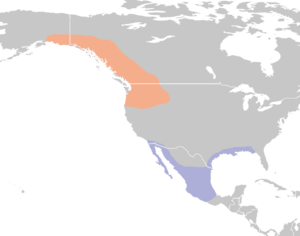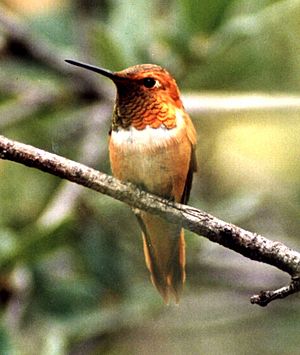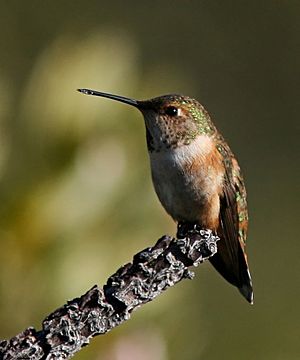Rufous hummingbird facts for kids
Quick facts for kids Rufous hummingbird |
|
|---|---|
 |
|
| Adult male | |
| Conservation status | |
| Scientific classification | |
| Genus: |
Selasphorus
|
| Species: |
rufous
|
 |
|
| Summer, breeding range Winter range | |
The rufous hummingbird (Selasphorus rufus) is a small hummingbird, about 8 cm (3.1 in) long with a long, straight and slender bill. These birds are known for their extraordinary flight skills, flying 2,000 mi (3,200 km) during their migratory transits. It is one of seven species in the genus Selasphorus.
Description
The adult male has a white breast, rufous face, flanks and tail and an iridescent orange-red throat patch or gorget. Some males have some green on back and/or crown. The female has green, white, some iridescent orange feathers in the center of the throat, and a dark tail with white tips and rufous base.
The female is slightly larger than the male. Females and the rare green-backed males are extremely difficult to differentiate from Allen's hummingbird. This is a typical-sized hummingbird, being a very small bird. It weighs 2–5 g (0.071–0.176 oz), measures 7–9 cm (2.8–3.5 in) long and spans 11 cm (4.3 in) across the wings.
They feed on nectar from flowers using a long extendable tongue or catch insects on the wing. These birds require frequent feeding while active during the day and become torpid at night to conserve energy. Because of their small size, they are vulnerable to insect-eating birds and animals.
Breeding
Their primary breeding habitats are open areas, mountainsides and forest edges in western North America from southern Alaska through British Columbia and the Pacific Northwest to California, nesting further north (Alaska) than any other hummingbird. The female builds a nest in a protected location in a shrub or conifer.
Migration
Western rufous hummingbirds migrate through the Rocky Mountains and nearby lowlands during May to September to take advantage of the wildflower season. They may stay in one local region for the entire summer, in which case the migrants, like breeding birds, often aggressively take over and defend feeding locations. Most winter in wooded areas in the Mexican state of Guerrero, traveling over 2,000 mi (3,200 km) by an overland route from its nearest summer home – a prodigious journey for a bird weighing only 3 to 4 g.
Most rufous hummingbirds that migrate to the southeast of the United States and Caribbean Islands are juvenile birds and adult females, with adult males seldom seen. Since juveniles or females are essentially indistinguishable from Allen's hummingbirds unless confirmed by close inspection, eastern rufous migrants may be classified as "rufous/Allen's hummingbirds".
Conservation
In 2018, the rufous hummingbird was uplisted from least concern to near threatened on the IUCN Red List, on the basis that due to its reliance on insect prey during the wintering season, it will be heavily affected by the global decline in insect populations due to pesticides and intensified agriculture. Due to climate change, many flowers that the rufous hummingbird feeds on during the breeding season have started blooming two weeks prior to the birds' arrival to their breeding locations, which may lead to rufous hummingbirds arriving too late to feed on them.
Gallery
Images for kids
See also
 In Spanish: Colibrí rufo para niños
In Spanish: Colibrí rufo para niños





